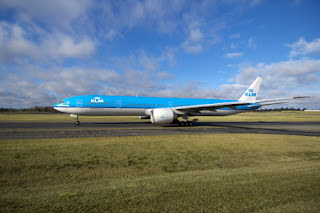 The U.K. Air Accidents Investigation Branch (AAIB) recently released a Special Bulletin in regard to the investigation of the British Airways Boeing 777 accident at London's Heathrow Airport last month. Included in the latest Bulletin is a safety recommendation for all operators of the Boeing 777 type aircraft.
The U.K. Air Accidents Investigation Branch (AAIB) recently released a Special Bulletin in regard to the investigation of the British Airways Boeing 777 accident at London's Heathrow Airport last month. Included in the latest Bulletin is a safety recommendation for all operators of the Boeing 777 type aircraft.Here's the link to the full text of AAIB Bulletin S1/2008 Special on the AAIB website. (It's a 6-page 'pdf' file.)
AAIB Safety Recommendation 2008-009 states:
Boeing should notify all Boeing 777 operators of the necessity to operate the fuel control switch to cut-off prior to operation of the fire handle, for both the fire drill and the evacuation drill, and ensure that all versions of its checklists, including electronic and placarded versions of the drill, are consistent with this procedure.The new safety recommendation arose from the finding during the AAIB's post-accident investigation that the spar valves on both engines of the accident aircraft (a B777-236ER, registration number G-YMMM) were found to be open. The function of the spar valves is to cut off the fuel flow to the engine in the event of an engine fire or an accident. The AAIB Bulletin notes that, while this was not in any way causal to the accident, it "could have had serious consequences in the event of a fire during the evacuation."
The AAIB Bulletin gives considerable attention to the open spar valves (see pages 5 and 6 of the Bulletin), concluding that the the fire handles had been operated prior to the fuel control switches. This is contrary to the sequence recommended by Boeing. Quoting from the Special Bulletin:
Boeing had issued a Service Bulletin (SB 777-28-0025) which advised the splicing together of the wires for the fuel control switches and the fire handles to avoid the need to sequence their operation. An FAA airworthiness directive requires this SB to be completed by July 2010. This had not yet been incorporated on G-YMMM; however, had it been incorporated, the right spar valve should have closed when the fuel control switch was operated.Here are the links to all three reports related to this accident investigation that have been issued to date by the AAIB:
The evacuation checklist for the Boeing 777, issued by Boeing, shows operation of the fuel control switches to cut-off prior to operation of the fire handles. This sequence allows for both CLOSE paths to the spar valve to be exploited and increases the likelihood that the spar valves close before electrical power to the spar valves is isolated. However, if the fire handle is operated first, then only a single path is available.
The operator’s evacuation checklist, for which Boeing had raised no technical objection, required the commander to operate the fuel control switches whilst the first officer operated the fire handles, this was in order to reduce the time required to action the checklist. These actions were carried out independently, with no measure in place to ensure the correct sequencing. The evacuation drill was placarded on the face of the control column boss, directly in front of each pilot.
An evacuation checklist with the division of independent tasks between the crew leaves a possibility that the fire handles could be operated before the fuel control switches which, with fire handle to spar valve wire damage, could leave the engine fuel spar shut-off valves in an OPEN position. This occurred in this accident, and resulted in the loss of fuel from the aircraft.
- AAIB Ref: EW/C2008/01/01 (Initial report)
- Initial Report Update - 23 January 2008
- AAIB Special Bulletin: 1/2008 - February, 2008














